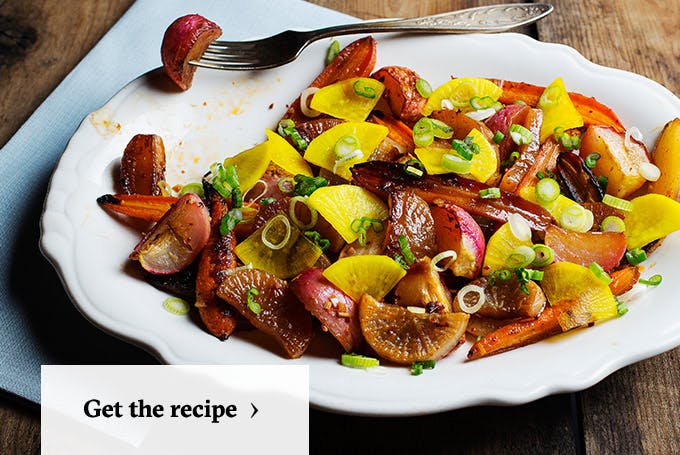What To Make With Daikon: Roasted Vegetables And Pickles
Give it up for daikon, sweetly roasted and pickled neon yellow
We may receive a commission on purchases made from links.
The humble daikon, a great white torpedo-shaped root vegetable, isn't exotic and trendy like dragon fruit or flashy like the last of the blood oranges, Meyer lemons and finger limes you'll find at the markets right about now. Just look at the literal translation of the word: dai means "big," and kon means "root."
It's a big root all right, plain and a bit gnarled in appearance, but in chefs' hands, it's been the sturdy, slightly wasabi-like blank canvas for salt-bakes, textural salads and, in our Test Kitchen, the base of a roasted and pickled side dish (see the recipe).
"Daikon is super versatile. I think of it kinda like the Bubba Gump Shrimp Co.: You can put it in everything," Matthew Lightner, the chef at NINEBARK in Napa, California, says.
Technically part of the brassicaceae family (hello, kohlrabi), daikon is best known as a supporting character in Japanese cooking, grated into a fluffy, wet mound and doused in ponzu or pickled and aglow in highlighter yellow as takuan. However, the root runs across Asia, roiling in a stew of tamarind pulp, lentils and spices for South Indian sambar or painstakingly shredded and packed into dim sum-style cakes in Cantonese cooking. You'll find them pale green, like the nose-clearing wasabi daikon, or crimson fleshed like the Chinese Red Meat variety, however, what you look for in a pristine vegetable is all the same.
"You're looking for daikon that's very firm and crisp, similar to an apple," Lightner says. "If it's softish and spongy, it's not fresh, and it's starting to die. So steer clear of those."
And whatever you do, don't you dare call them radishes.
"It always annoys me when daikon is translated as 'radish,' because it's such an incredibly versatile vegetable," Sylvan Mishima Brackett, the chef/owner of Rintaro in San Francisco, California, laments. "Like an egg, it can be used in dozens of ways."
Brackett simmers daikon in leftover rice-washing water for beef tendon stew and garnishes whole grilled fish—"Mounted to look like a miniature Mount Fuji," he says. At NINEBARK, Lightner buries the root vegetable in salt before serving it with hardwood-smoked sturgeon collar—"The benefit of salt-baking something like a daikon is that you can impart salinity into it without waterlogging it," he adds. And at Bara in New York City, chef Ian Alvarez builds the "Voltron" of salads with matchsticks of daikon, but he's into cooking it, too.
"The fact that it has such a sturdy structure means that it can hold up to double methods of cooking, first in a wet environment like simmering to soften the texture and impart flavor, then a dry method like grilling or broiling to get some of that good ol' Maillard reaction, rendering the naturally present sugars a roasty brown," Alvarez says. "Super meaty and delicious."
So we took the second route for our daikon, tossing half-moons with gochujang, honey and soy sauce and baking the sticky-sweet mix until caramelized. However, it was missing something, a certain neon yellow something.
"Takuan pickles are probably the most troublesome daikon preparation that I do," Nancy Singleton Hachisu, the author of Preserving the Japanese Way, details. "I had some issues with getting the water to come out from the root into the powdery rice bran, so sometimes had spoilage. You have to really watch the initial period when making takuan, and you have to pile on more rocks than you can imagine to weight the daikon and squeeze out the water."
For the record, we ditched the old-school rock-pressing technique—city kitchens, what can we say—to make the crisp, tangy Technicolor pickles you normally see alongside Japanese curries and nestled into bento boxes. Instead, we quick-pickled daikon in rice vinegar, salt and sugar, and, of course, turmeric for that signature pop of color.
Roasted with gochujang and spiked with turmeric, this daikon is to die for.

